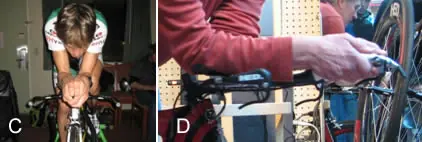The more your shoulders roll in the narrower your shoulders will get and the faster you will be. This can save you another 100 to 200 grams of drag. Again, angling your aerobars slightly upward might enable you to narrow your shoulders more comfortably. Moving your elbows closer together may also help.
We use giant calipers that we call "manipers" to measure shoulder width and ensure that as the elbows come closer together, the shoulders follow. Eventually, you will get to a point where your shoulders are unaffected by further reductions in the distance between your elbows, and that's the point where you'll want to stop (see photo C for an example of good, narrow shoulders).
Aero Positioning
There is no apparent effect of aerobar shape and aerodynamics. S-bends offer the most powerful position but are not necessarily the most comfortable. Finding a balance between power and comfort is important. While pulling up on the bar (which is a real power position), the more rotated your wrist becomes, the more leverage you can generate. The more angle there is in a single bend, the less power you will have pulling up.
The variety of hand positions that are possible with S-bends makes it easier to find a position that optimizes power and comfort. The key to proper S-bend positioning is to make sure that your ring finger is lined up with your elbow (see photo D). This will prevent the wrist and forearm discomfort often seen with ill-fitted S-bend aerobars.

Also, avoid angling your aerobars downward. This not only increases your frontal area, it also raises your effective bar height, causing you to ride "taller" and further increasing your frontal area.
Many triathletes assume that the surest way to increase the aerodynamics of the riding position is to drop your bars and lower your torso, but this is not always the case. A better indicator of aerodynamic positioning, from a side view, is how low the head is. A greater sternum angle may actually facilitate a lower head position because the rider is not forced to keep his or her head back to see forward (see photo E).
Using a goniometer, we measure an athlete's sternum angle rather than hip angle. It is certain that if your sternum angle goes below five degrees, you will be slower than if it were at five to15 degrees. We actually raise some riders because their net drag is unaffected by going a little higher, as the steeper their torso angle is, the more they can lower their heads.
This is not to suggest that your back position is not important to aerodynamics. However, what matters is not how low it is but how you hold it. You want to strive for a slight curve in your mid-spine, almost like a hump. This will help integrate your aero helmet into your streamlined position (see photo F). Specifically, it will help smooth airflow over your aero helmet, integrating your aero tuck into a neat little package and lowering your drag numbers another 50 to 100 grams.

There is a principle in aerodynamics that states that air likes to flow over curved surfaces as opposed to flat ones. Consider the toroidal bulges of aero wheels versus flat sidewall wheels. If you have a naturally flat back, work on curving your back into a hump, and if you have a humpback, rejoice, because it will help you ride faster.
It is important to note that the best time trialers and triathletes in the world all work very hard to make the unnatural natural. Almost everyone who attempts to modify his or her position according the guidelines I've just given you comes back to me after the first few rides complaining about feeling uncomfortable.
Be patient, as it takes time to first get into the right position and then learn to pedal, steer, corner, drink and feed in it. When it does become tolerable and eventually comfortable (and it always does), your persistence will be rewarded with significantly faster bike-splits.


